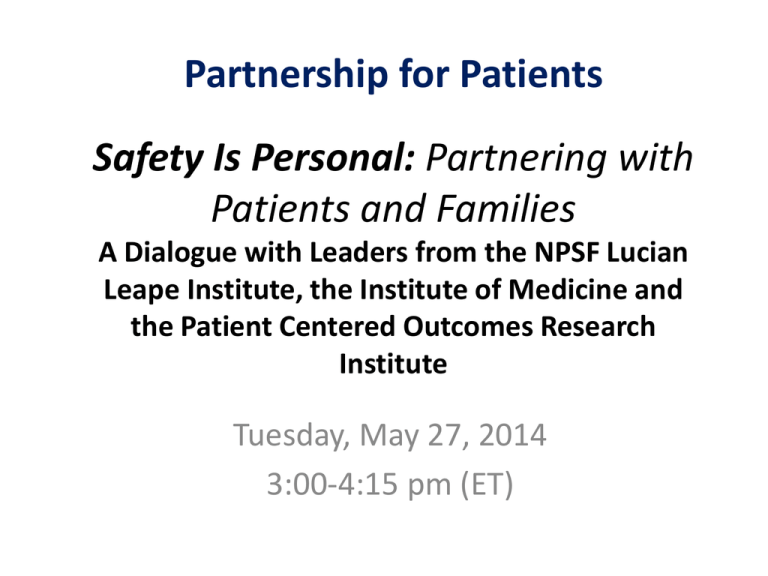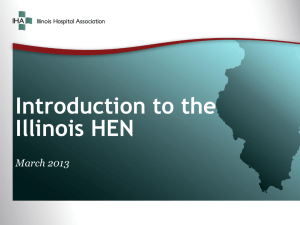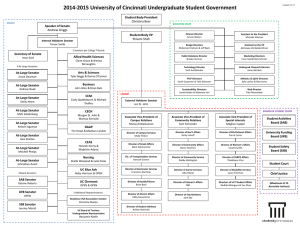View Power Point - North Carolina Quality Center
advertisement

Partnership for Patients Safety Is Personal: Partnering with Patients and Families A Dialogue with Leaders from the NPSF Lucian Leape Institute, the Institute of Medicine and the Patient Centered Outcomes Research Institute Tuesday, May 27, 2014 3:00-4:15 pm (ET) Welcome Martin Hatlie NCD 2 Partnership for Patients Campaign 196 Days and Counting! Our Patients are Counting on You! 3 Objectives • To learn about the recommendations of the NPSF Lucian Leape Institute for hospital leaders, clinicians and staff, consumers and policy makers in advancing PFE. • To understand what PCORI and IOM are doing to support research, disseminate evidence and engage PFACs • To spur action on emerging opportunities for patient advocates, hospitals and HENs to operationalize PFE as an SAB strategy Questions to Run on • What more can HENs, hospitals and patient advocates do to achieve the recommendations of the NPSF Lucian Leape Institute’s Safety Is Personal report? • How can PFACs use the resources & opportunities created by IOM, PCORI and others to best use the forward energy of patient advocates to improve outcomes? • Safety IS personal, so what more can I do to engage patient advocates in improving Safety Across the Board as quickly as possible? Partnership for Patients 2 Bold Aims: 40/20 by 12/31/14 http://partnershipforpatients.cms.gov Who is on the call today? a) b) c) d) e) f) g) Hospital administrator Hospital staff HEN (Director or Staff) QIO Federal Agency Partner Patient / Patient Advocate Other 7 Maximizing PFE to Improve Outcomes Dennis Wagner and Paul McGann, MD CMS PfP Co-Directors Partnership for Patients Signature Attributes of the Campaign • • • • • Thrilling goals Urgency Relentless focus on results Inclusion & health equity Safety Across the Board (SAB) • PFE – Important in itself – Embedded in the Campaign – An SAB strategy Goal line in Sight • 196 days • Harvesting results so far • Relentless focus on more results – LEAPT • Partnering to sustain action • Reducing cycle time • Expediting use of PFE structures to achieve SAB and reduce disparity PFE Success Story - Falls Fall Prevention Center Mission • Alameda Health System has a Fall Prevention Center (FPC) whose mission is to identify older adults who are at risk for falls • Alameda provides screenings, medication reviews, fall prevention education, Geriatrician consults and interventions as needed that help decrease their fall risk and therefore reduce the number of preventable falls • Since its inception (Sept. 2011) the FPC has been successful in keeping 93% of its patients out of the Emergency Department due to an additional fall RARE: Reducing Avoidable Readmissions Effectively in Minnesota • Goal: Engage hospitals and care providers in Minnesota across the continuum of care to prevent 6,000 avoidable hospital readmissions within 30 days of hospital discharge • Dates: 7/1/2011 - 12/31/2013 • Participants: 82 hospitals, 100 community partners • Triple Aim: 1. 2. 3. 6,000 avoidable hospital readmissions 24,000 nights sleep in patients’ own beds Tens of millions of dollars saved RARE (continued) Areas of Focus: 1. Patient and family engagement: Ensuring processes are in place to: – Engage patients/family – Elevate the status of family caregivers as essential members of the team – Prepare the patient and family to manage care at home. – Interventions may include: – Teach back – Collaborative conversations and communication – Simulations with the patient and family member 2. 3. 4. 5. Comprehensive discharge planning Medication management Transition care support Transition communications Results • 7,030 readmissions avoided (as of Q3 2013) – Exceeded original goal of 6,000 readmissions • Helped patients spend 24,844 more nights sleeping comfortably in their own beds • Reduced inpatient costs by an estimated $55 million • 2013 winner of the John M. Eisenberg Patient Safety and Quality Award for Innovation in Patient Safety and Quality MHA’s “RARE” Campaign Reducing Avoidable Readmissions Effectively • Minnesota hospitals have collectively prevented 7,975 Readmissions and helped patients spend 31,900 nights at home instead of in the hospital • In the last quarter of 2013, Minnesota hospitals reached a collective reduction in Readmissions of 19 percent Source: Data from RARE website http://www.rarereadmissions.org/ Patient & Family Engagement PfP Campaign Metrics Patient and Family Advisory Council A hospital-wide champion for Safety Across the Board Where are we today on establishing hospital PFACs? Does your hospital have a Patient and Family Advisory Council? 41% of 1,438 responding hospitals have a PFAC; 28% are hospital-wide. (AHA/HRET 2013 survey of all hospitals) HENs Report As of May, 2014 there are 1,483 hospitals with PFACs or Patients on Safety Committee Time for a Boost: HENs report formation of PFAC or Patient on Safety Committee has leveled out. How are the HENs doing in spreading PFACs among member hospitals? Percent of HEN Network Hospitals with PFACs or Patients on Safety Committees, as of May 2014 Percent of AHA/HRET Network Hospitals with PFACs/Pt on Pt Safety Committee in Place – May 2014 Shout out! HENs and HRET/SHAs who have over 75% of their hospitals with PFACs/Pts on Patient Safety Committees in place. Hospital Engagement Network Number of Hospitals In Network With PFAC/Pt on Pt Safety Comm. Dignity 35 35 Pennsylvania 106 104 AHA/HRET Massachusetts SHA 16 16 AHA/HRET Connecticut SHA 25 24 AHA/HRET Alaska SHA 12 10 AHA/HRET DC 2 2 Rhode Island SHA 8 6 Patient Perspective Linda K. Kenney, President and Founder MITSS - Medically Induced Trauma Support Services Roundtable Participant NPSF Lucian Leape Institute, Safety is Personal NPSF Lucian Leape Institute Faculty Lucian L. Leape, MD Chair, NPSF Lucian Leape Institute Adjunct Professor of Health Policy Harvard School of Public Health Susan Edgman-Levitan, PA Member, NPSF Lucian Leape Institute Executive Director, John D. Stoeckle Center for Primary Care Innovation, Massachusetts General Hospital Tejal K. Gandhi, MD, MPH, CPPS President, National Patient Safety Foundation and NPSF Lucian Leape Institute 26 The National Patient Safety Foundation’s Lucian Leape Institute • Mission • Strategic Focus • Transforming Concepts 27 Members of the NPSF Lucian Leape Institute Lucian L. Leape, MD, Chair Adjunct Professor of Health Policy Harvard School of Public Health Gary S. Kaplan, MD, FACMPE Chairman and CEO Virginia Mason Medical Center Tejal K. Gandhi, MD, MPH, CPPS President, NPSF Lucian Leape Institute President, NPSF Julianne M. Morath, RN, MS President & CEO Hospital Quality Institute of California Carolyn M. Clancy, MD Assistant Deputy Undersecretary for Health, Quality, Safety and Value Veterans Health Administration Dennis S. O’Leary, MD President Emeritus The Joint Commission Janet M. Corrigan, PhD, MBA Distinguished Fellow The Dartmouth Institute for Health Policy and Clinical Practice Susan Edgman-Levitan, PA Executive Director John D. Stoeckle Center for Primary Care Innovation Massachusetts General Hospital 28 Paul O'Neill Former Chairman and CEO, Alcoa 72nd Secretary of the U.S. Treasury Robert M. Wachter, MD Associate Chair Department of Medicine University of California San Francisco NPSF LLI Transforming Concepts • Medical education reform • Integration of care within and across delivery systems • Restoration of joy and meaning in work and ensuring the safety of the health care workforce • Active consumer engagement in health care • Transparency as a practiced value in everything we do in health care Leape L, Berwick D, Clancy C, et al., for the Lucian Leape Institute at the National Patient Safety Foundation. 2009. Transforming healthcare: a safety imperative. Qual Saf Health Care 18(6):424-428. doi:10.1136/qshc.2009.036954. 29 Safety Is Personal: Partnering with Patients and Families for the Safest Care From the NPSF Lucian Leape Institute Roundtable on Consumer Engagement Download at http://www.npsf.org/lli/safety-ispersonal 30 Four Levels of Engagement 31 NPSF LLI Patient Engagement Recommendations • Leaders of health care systems: – Establish patient and family engagement as a core value for the organization – Involve patients and families as equal partners in the design and improvement of care across the organization and or practice. Educate and train all clinicians and staff to be effective partners with patients and families – Partner with patient advocacy groups and other community resources to increase public awareness and engagement 32 NPSF LLI Patient Engagement Recommendations • Health care clinicians and staff: – Provide information and tools to support patients and families to engage effectively in their own care – Engage patients as equal partners in safety improvement and care design activities – Provide clear information, apologies and support to patients and families when things go wrong 33 NPSF LLI Patient Engagement Recommendations • Health care policy makers: – Involve patients in all policy-making committees and programs – Develop, implement and report safety measures that foster transparency, accountability, and improvement – Require that patients be involved in setting and implementing the research agenda 34 NPSF LLI Patient Engagement Recommendations • Patients, families and the public: – Ask questions about the risks and benefits of recommendations until you understand the answers – Don’t go alone to the hospital or doctor visits – Always know why and how you take your medications, and their names – Be really clear about the plan of action – Say back in your own words what you think you hear from clinicians 35 NPSF LLI Patient Engagement Recommendations • Patients, families and the public (cont’d): – Arrange to get any recommended lab tests done before a visit – Determine who is in charge of your care 36 Characteristics of Excellent Patient/Family Partners • The ability to share personal experiences in ways that others will listen and learn from them. • The ability to see the “big” picture. • Interested in more than one issue. • Interested in improving health care or research. 37 • The ability to ask tough questions constructively. • The ability to connect with people. • A sense of humor. • Representative of the relevant patients/ families/conditions. Chinese Proverb Those who say it cannot be done should not interrupt the person doing it. - Chinese proverb 38 Organizations in Action Susan E. Sheridan, MBA MIM, Director of Patient Engagement, Patient Centered Outcomes Research Institute J. Michael McGinnis, MD MA, MPP Senior Scholar and Executive Director, Roundtable on Value & Science-Driven Health Care Institute of Medicine Networking, Learning and Evidence: Strengthening the Foundation for Progress Institute of Medicine of the National Academy of Science http://www.iom.edu/ From Partnership in Care to Partnership in Research Sue Sheridan Patient Engagement Mission PCORI helps people make informed health care decisions, and improves health care delivery and outcomes, by producing and promoting high integrity, evidence-based information that comes from research guided by patients, caregivers and the broader health care community. PCORI Emphasizes Engagement for Getting to Practical, Useful Research Funded Projects to Date Total number of research projects awarded: 279 Total funds awarded: $464.2 million Number of states where we are funding research: 38 states (plus the District of Columbia and Quebec, Canada) 15 Our National Priorities for Research 9 Improving Healthcare Systems Projects that address critical decisions that face healthcare systems, the patients and caregivers who rely on them, and the clinicians who work within them. 41 Awards $76.5 Million 19 Facilitating Patient Partnership in Research 47 Pipeline to Proposals Find Us Online 39 Insights and Responses Bernard Roberson Administrative Director of Patient Family Centered Care, Georgia Regents Medical Center Knitasha Washington, DHA, FACHE NCD Lisa Morrise, MA Consumer Co-Chair, Patient and Family Affinity Group HENs in Action with HEN-wide PFE Collaboratives • Joint Commission Resources • Minnesota • Carolinas • Dignity • Pennsylvania • Washington State • Ohio Children’s • UHC • • • • • NoCVa VHA AHA/HRET Georgia America’s Essential Hospitals • LifePoint • New Jersey • Premier PFE as an SAB Strategy • NoCVa – HEN-wide collaborative to assist hospitals plan, get leadership on board & implement PFACs focused on SAB ASAP • VHA – HEN level “partnership council with patient advocates and hospital executives – VHA member hospital collaborative • HRET – BoD level initiative to “eliminate harm across the board” – July 2014 “Roadmap” event to enroll hospital safety leaders and PFAC members in SAB works – CanDOR Project funded by AHRQ 2nd Annual Quality & Patient Safety Roadmap (San Diego, July 19-22) Symposium for Leadership In Healthcare Quality Focus: • Eliminating HAB • High Reliability Organizations • BoD engagement • PFACs as integral to success Opportunity: • AHA/HRET pays costs of up to 125 PFAC members who come with hospital leaders • Increase diversity of PFAC members Patient Advocacy Patient Advocacy Patient Advocacy Groups in Action in Action on PFE Groups in Action with Groups as a Strategy for SAB the PFE Campaign • Institute for Patient and Family Centered Care • National Partnership for Women and Families • Beryl Institute • Caregiver Action Network • Others • Patient and Family Centered Care Partners • Consumers Advancing Patient Safety • Mothers Against Medical Error PfP HEN Disparities Matrix PfP HEN Disparities Matrix Offers & Requests • PCORI research pipeline • HRET support for PFAC members to attend SAB Roadmap event in July • Collaborative to engage senior leaders in establishing PFACs to advise on SAB • Collaborative to engage patient advocates in understanding SAB and their role in hospital SAB work Polling Question for Patient Advocates Which of the following statements best describes your interest in participating in a in webinar series designed to inform and give you command of Safety Across the Board (SAB) and the roles you can play in advancing SAB at the hospital(s) you rely on for care? a) I am on a PFAC and am interested in this opportunity. b) I am interested in this opportunity and will inform others in my PFAC who might also be interested. c) I am not ready to take advantage of this opportunity at this time, but will inform others in my PFAC about the opportunity. d) I am not ready to take advantage of this opportunity at this time and am not on a PFAC, but will inform other patient advocates in my network about this opportunity. Polling Question for Hospitals Which of the following statements best describes your hospital’s interest in a campaign designed to get hospital senior leadership commitment to install by Dec. 2014 a PFAC with a role in Safety Across the Board? a) Our hospital would definitely participate in this opportunity if offered. b) Our hospital would potentially consider this opportunity if offered. c) In our hospital, senior leadership is already fully committed to PFE as a SAB strategy and we are in action. d) We are not interested in this opportunity at this time, but may be interested in the future. Polling Question for HENs Which of the following statements best describes your HEN’s interest in a campaign designed to get hospital senior leadership commitment to install by Dec. 2014 a PFAC with a role in Safety Across the Board? a) Our HEN would definitely participate in this opportunity if offered. b) Our HEN would potentially consider this opportunity if offered. c) In our HEN, senior leadership is already fully committed to PFE as a SAB strategy and we are in action. d) We are not interested in this opportunity at this time, but may be interested in the future. Join Our PFE Network To add patient advocates to the National PFE Network please contact Kelly at Weber Shandwick by email at: KAbrahamson@webershandwick.com Links and Resources • • • • NPSF LLI Safety is Personal www.IOM.edu www.PCORI.org AHA/HRET 2nd Annual Roadmap Event, San Diego, July 19-22, 2014 Thank you for joining us today! Upcoming pacing event: Aligning Forces For CAUTI Prevention June 3, 2014











